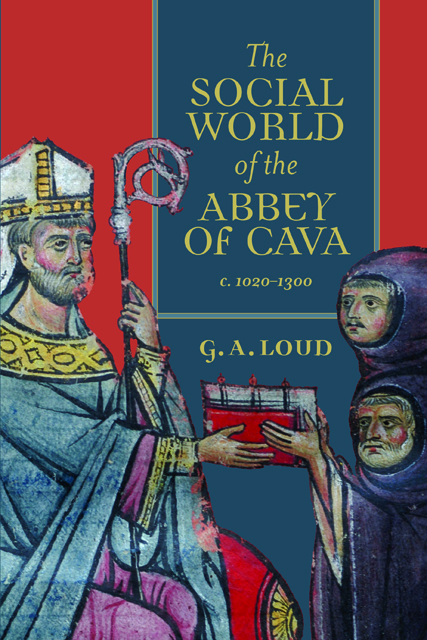Book contents
- Frontmatter
- Dedication
- Contents
- List of Maps and Charts
- Acknowledgements
- List of Abbreviations
- Note on the Organisation and Publication of the Cava Archive
- Dates
- Currency, Weights and Measures
- The Abbots of Cava, c. 1020-1300
- Maps
- I The Family of Vivus Vicecomes
- Introduction
- Part I The Abbey of Cava
- Part II Society and Economy
- Conclusions
- Appendix: Purchase and Expenditure by the Abbey of Cava, at Selected Periods between 1175 and 1230
- Bibliography
- Index
- Other volumes in Studies in the History of Medieval Religion
2 - The Era of Growth, c. 1076-1190
Published online by Cambridge University Press: 14 January 2023
- Frontmatter
- Dedication
- Contents
- List of Maps and Charts
- Acknowledgements
- List of Abbreviations
- Note on the Organisation and Publication of the Cava Archive
- Dates
- Currency, Weights and Measures
- The Abbots of Cava, c. 1020-1300
- Maps
- I The Family of Vivus Vicecomes
- Introduction
- Part I The Abbey of Cava
- Part II Society and Economy
- Conclusions
- Appendix: Purchase and Expenditure by the Abbey of Cava, at Selected Periods between 1175 and 1230
- Bibliography
- Index
- Other volumes in Studies in the History of Medieval Religion
Summary
Robert Guiscard
Both during the siege of Salerno, and after the city’s eventual surrender, Robert Guiscard did his best to appear as a merciful conqueror, a benevolent ruler and as the legitimate successor to the Lombard prince he had displaced. The contemporary chronicler, and ducal apologist, Amatus of Montecassino described Robert welcoming kindly and supporting those who had fled from the city before and during the siege, honouring Archbishop Alfanus (who had defected to his side), and once the city was captured having a market set up and food brought in to be sold cheaply to relieve the famished inhabitants. Amatus also claimed that the duke could easily have taken Salerno by storm, but was reluctant to do so because he wanted to avoid the loss of life and property that would have occurred during the inevitable sack after it was taken, preferring instead to wait until the city was betrayed to him. Amatus ascribed this restraint to the duke’s merciful instincts (to which he contrasted Prince Gisulf’s cruelty), but it was also good policy, enabling Robert to win over the citizens willingly to accept his rule. Once the city was secured, existing local officials and the urban patriciate remained in place, the current coinage was continued with only cosmetic changes, and in some of his diplomata Robert tactfully adapted his regnal style to read: ‘duke of the Normans, Salernitans, Amalfitans, Sorrentines, Apulians, Calabrians and Sicilians’. He also set about making Salerno his capital, or at the least his principal residence.
Patronage of the Church played an important role in this policy of continuity and, rather self-conscious, benevolence. Churchmen were after all the principal opinion-formers of the time, and Robert needed to reward those who had joined the winning side. He also had need of their prayers, both to influence others and to secure his own salvation. So, for example, he rewarded his ally Archbishop Alfanus by confirming the extensive and newly augmented possessions of his see in October 1080, by honouring the relics of St Matthew, the patron of the see, that were fortuitously rediscovered by the archbishop in that same year, and by financing the rebuilding of his cathedral. This generosity was duly recorded in one of the archbishop’s verses inscribed on the architrave above the main entrance to the cathedral for all to see.
- Type
- Chapter
- Information
- The Social World of the Abbey of Cava, c. 1020-1300 , pp. 25 - 67Publisher: Boydell & BrewerPrint publication year: 2021



